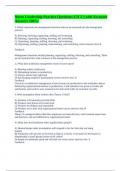Nurse Leadership Practice Questions-CH 2 || with Accurate
Answers 100%.
1. Which represents the management functions that are incorporated into the management
process?
A) Planning, directing, organizing, staffing, and evaluating
B) Planning, organizing, staffing, directing, and controlling
C) Organizing, planning, staffing, directing, and evaluating
D) Organizing, staffing, planning, implementing, and controlling correct answers Ans: B
Feedback:
Management functions include planning, organizing, staffing, directing, and controlling. These
are incorporated into what is known as the management process.
2.) What does traditional management science focuses upon?
A) Meeting worker satisfaction
B) Delineating barriers to productivity
C) Using a laissez-faire approach
D) Encouraging employee participation correct answers Ans: B
Feedback:
Classical, or traditional, management science focuses on production in the workplace and on
delineating organizational barriers to productivity. Little attention was given to worker job
satisfaction, and workers were assumed to be motivated solely by economic rewards.
3. What assumption about workers does Theory X hold?
A) Workers will naturally put forth effort
B) Workers need threats to be motivated
C) Workers are diligent and responsible
D) Workers are in tune with organizational needs correct answers Ans: B
Feedback:
Theory X managers believe that their employees are basically lazy, need constant supervision
and direction, and are indifferent to organizational needs.
4.) What does the Hawthorne effect implied about people?
A) Human beings under investigation will respond to the fact that they are being
studied
B) Production will increase or decrease as light in a factory is increased or decreased C)
Membership in small groups forms social control
D) People are inherently good and will seek out work correct answers Ans: A
Feedback:
, Hawthorne effect indicated that people respond to the fact that they are being studied, attempting
to increase whatever behavior they feel will continue to warrant the attention. The other
statements do not reflect implied beliefs about people.
5.) Managing conflict among staff members would occur in which part of the management
process?
A) Planning
B) Organizing
C) Directing
D) Evaluating correct answers Ans: C
Feedback:
Directing sometimes includes several staffing functions. However, this phases functions usually
entail human resource management responsibilities, such as motivating, managing conflict,
delegating, communicating, and facilitating collaboration. Planning encompasses determining
philosophy, goals, objectives, policies, procedures, and rules; carrying out long- and short-range
projections; determining a fiscal course of action; and managing planned change. Organizing
includes establishing the structure to carry out plans, determining the most appropriate type of
patient care delivery, and grouping activities to meet unit goals.
6. What is the idea that workers should be hired, trained, and promoted based on their
competence and abilities related to?
A) Part of the management functions identified by Fayol
B) The result of the human relations studies
C) The outcome of studies done by Mayo at the Hawthorne Works
D) One of the four overriding principles of scientific management correct answers Ans: D
Feedback:
Frederick Taylor, the ifather of scientific management,i had the idea that workers should be
hired, trained, and promoted based on their competence and abilities. This concept is not
associated with any of the other options.
7. Max Weber, a well-known German sociologist, began to study large-scale organizations to
determine what made some more efficient than others. What was his conclusion?
A) Workers had to have a say in management to work most effectively
B) Consistent rules and regulations for workers increased efficiency
C) Employees should feel appreciated and valued
D) Workers need frequent rest periods to increase overall production correct answers Ans: B
Feedback:
Weber saw the need for legalized, formal authority and consistent rules and regulations for
personnel in different positions. He thus proposed bureaucracy as an organizational design. None
of the other options reflect his conclusions.
8. Which leadership style maintains strong control over the work group and uses coercion to
motivate others?




